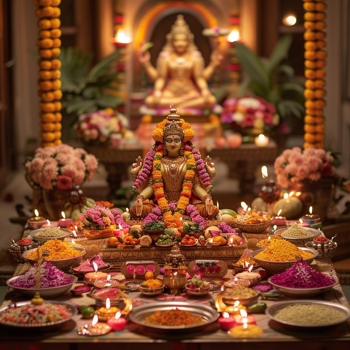Dussehra, also known as Vijayadashami, holds profound significance in India, symbolizing the victory of good over evil. This festival commemorates the triumph of Lord Rama over the demon king Ravana, as narrated in the epic Ramayana12. It also marks the end of the nine-day Navratri festival and the Durga Puja celebrations, which honor the goddess Durga’s victory over the buffalo demon Mahishasura
in the Hindu tradition. It is a continuous, uninterrupted recitation of the entire Ramayana, usually completed within 24 to 30 hours. This practice is more than just a reading; it is a deep spiritual ritual that connects devotees with the divine essence of Lord Rama and his teachings.
The uninterrupted nature of the recitation symbolizes the eternal and unbroken devotion to Lord Rama. It is a means to invoke the divine presence, purify the environment, and sanctify the space where it is performed.
The Akhand Ramayan is often conducted during significant festivals and life events, marking moments of great importance with the divine narrative of virtue, devotion, and righteousness.
Celebrating Dussehra offers several benefits, both culturally and personally:
Benefits of Dussehra Puja
- Spiritual Enlightenment:
- The rituals of Navaratri followed by Dussehra help align the body, mind, and soul, bringing clarity and spiritual growth.
- Protection from Negative Forces:
- Worshipping the fierce forms of Durga, such as Kalaratri, provides protection against negative energies, fear, and evil influences.
- Fulfillment of Desires:
- Devotees offer prayers to Katyayani for the fulfillment of personal desires, especially those seeking marriage and prosperity.
- Inner Strength and Courage:
- Praying to the different forms of Durga strengthens mental fortitude, courage, and the ability to face challenges in life.
- Health and Well-being:
- Many believe that the puja rituals cleanse the environment and one's energy, contributing to physical health and emotional balance.
- Prosperity and Abundance:
- Worshipping deities like Shailaputri and Skandamata is believed to attract prosperity, abundance, and the well-being of the family.
- Wisdom and Knowledge:
- Offering prayers to Mahagauri and Siddhidatri can help in attaining higher knowledge and spiritual wisdom, guiding devotees on their path to enlightenment.
- Victory in Personal Life:
- Just as Lord Rama achieved victory over Ravana, devotees seek victory in their own struggles—be it personal, emotional, or professional.
- Promotion of Unity and Harmony:
- The festival encourages community bonding and cultural unity, fostering a sense of togetherness among family and society.
Through Dussehra Puja, devotees not only celebrate divine victories but also seek to overcome their own obstacles, aiming for a life of righteousness, courage, and spiritual success.
Overall, Dussehra is a celebration that enriches cultural identity, strengthens community ties, and promotes personal growth and ethical living .
Dussehra, also known as Vijayadashami, is a major Hindu festival celebrated across India, symbolizing the victory of good over evil. The festival is associated with the victory of Lord Rama over the demon king Ravana, and also the triumph of Goddess Durga over the buffalo demon Mahishasura. Performing Dussehra Puja involves rituals that can vary depending on regional traditions, but the general steps are quite similar.
Here's a step-by-step guide to performing Dussehra Puja at home:
1. Preparation:
- Clean the House: Before the puja, thoroughly clean the house to purify the space.
- Puja Thali: Prepare a puja thali (plate) with the following items:
- Kalash (a metal pot filled with water)
- Flowers, preferably marigolds
- Fruits and sweets for offering
- Diya (lamp)
- Incense sticks (agarbatti)
- Roli (kumkum) and rice grains (akshat)
- Coconut
- Betel leaves and nuts
- A small idol or picture of Lord Rama or Goddess Durga
- Holy water (Ganga jal)
- Durva grass and/or nine different types of grains (navadhanya) if you are following a more detailed ritual.
2. Setting Up the Altar:
- Install the Deities: Place the idol or picture of Lord Rama or Goddess Durga on a clean altar. You can also place images of Lord Hanuman, Lakshman, and Sita if available.
- Kalash Setup: Place the Kalash filled with water on the altar. Decorate it with mango leaves and place a coconut on top. This represents the presence of divine energy.
3. Invocation (Dhyana):
- Lighting the Lamp: Light the diya (lamp) and incense sticks. This symbolizes the removal of darkness and the presence of divine light.
- Sprinkling Holy Water: Sprinkle holy water around the altar to purify the space.
- Invoke the Deity: Meditate on Lord Rama or Goddess Durga, and chant the following mantra or your preferred deity’s mantra:
- For Rama: "Om Sri Ramaya Namah"
- For Durga: "Om Dum Durgayei Namah"
4. Puja Rituals:
- Offerings (Naivedya): Offer flowers, fruits, sweets, and other items from the puja thali to the deity.
- Apply Tilak: Apply tilak on the foreheads of family members with roli and rice grains.
- Aarti: Perform aarti by rotating the lamp in a circular motion in front of the deity. Sing the aarti song for Lord Rama or Goddess Durga, or chant "Om Jai Jagdish Hare" if you do not know a specific aarti.
- Mantra Chanting: Chant mantras or recite the Ramayana or Durga Saptashati, depending on which form of worship you are following.
- Durga Visarjan (if applicable): If you have kept a clay idol of Goddess Durga for the Navratri celebrations, immerse it in water on Dussehra, signifying her return to the divine realm.
5. Special Rituals (Regional Specific):
- Shami Tree Puja: In some regions, it is customary to worship the Shami tree on Dussehra, recalling how Lord Rama received blessings from the tree before going to battle with Ravana. Offer flowers, fruits, and water to the Shami tree, if accessible.
- Weapon Worship: Dussehra is also a day to worship tools and weapons (Ayudha Puja). Place your tools, books, or weapons on the altar and perform a simple puja by offering flowers and applying tilak.
- Ravana Effigy Burning: In many places, effigies of Ravana, Meghnath, and Kumbhkaran are burned to signify the victory of good over evil. If you're part of a community celebration, participate in this event.
6. Prayers and Conclusion:
- Final Prayers: Conclude the puja by offering heartfelt prayers for the well-being of your family and for victory over the negative forces in your life.
- Distribute Prasad: Distribute the prasad (offered sweets and fruits) among family members and neighbors.
7. Social and Cultural Activities:
- Participate in Cultural Programs: If there are any local plays (Ram Leela) or other cultural programs, it’s traditional to participate or watch them.
- Exchange Greetings: Visit friends and family, exchange sweets, and greet each other with blessings of Dussehra.
8. Immersion (Visarjan) (if applicable):
- Goddess Durga’s Idol Immersion: If you performed Navratri, immerse the idol of Durga in a river, pond, or ocean as a final act of the festival.
9. Feast:
- Festive Meal: Prepare and enjoy a festive meal with family and friends to celebrate the occasion.
This is a general guide to Dussehra Puja. Feel free to adapt it according to your family traditions and the specific deities you worship during this time.




